
 CN / EN
CN / EN
Zhejiang Ocean University
Wave energy, as an emerging energy source, boasts a promising future and market potential. Currently, various wave energy devices have been designed and developed both domestically and internationally to boost the utilization of wave energy. Among these, the pontoon-type wave energy device represented by the British Pelamis stands out as a great option for offshore wave power generation due to its simple structure, strong survivability, and high conversion efficiency.
To enhance the working efficiency of pontoon-type wave energy devices, numerous scholars both domestically and internationally have conducted in-depth research. This includes modifying the structural dimensions, draft, and shape of the devices, or adding extra components like damping plates and tension springs to improve their wave energy capture efficiency. Research indicates that optimizing the hinging connections can significantly boost the device's pitch motion frequency and broaden its low-frequency capture bandwidth.
Regarding the hinging connection mode, Associate Professor Xu Peng and his research team from the School of Marine Engineering at Zhejiang Ocean University, along with graduate student Chen Xuan Yu, have proposed an innovative dual-hinging configuration design. This design aims to optimize the connection mode between floats to enhance energy capture efficiency and expand the low-frequency capture bandwidth. The research findings have been published in the top international engineering journal "Energy" (Zone 1 of the Chinese Academy of Sciences, TOP journal).
I. Research Proposal
The research focuses on improving the wave energy capture efficiency of pontoon-type wave energy converters (WECs) by optimizing the hinging connections. This addresses issues such as high failure rates of hydraulic system-based pontoon WECs in practical engineering, susceptibility to damage from heavy loads, low power generation efficiency and poor adaptability in nonlinear waves, and short survival times.
The research team adopted a combined approach of experimental and numerical simulation methods. They systematically assessed the effects of single-hinging and dual-hinging configurations on the performance of dual-pontoon WECs. To gain a more realistic understanding of the WEC's performance under marine conditions, they further examined the energy capture efficiency and hinging link load of the two configurations under irregular waves and varied wave incidence angles. The research plan includes:
Experimental Design: Physical models of single-hinged and dual-hinged dual-link dual-floaters were constructed and tested in a towing tank to study their six-degree-of-freedom motion response and changes in mooring tension.
Numerical Simulation: After validating the numerical model with experimental data, multidimensional numerical simulation research on the energy capture characteristics of dual-floaters under different hinging configurations was conducted using the weakly nonlinear three-dimensional potential flow software AQWA.
Application of Motion Capture Technology: The Qing Tong Vision Motion Capture System was used to monitor key data such as the floaters' pitch response, relative angular velocity, and mooring tension in real-time, providing high-precision dynamic response data support for the experiment.
II. Physical Model Experiment
1.Experimental Setup
The experiment was conducted in a tank measuring 130 meters in length, 6 meters in width, and with a maximum water depth of 4.0 meters. A wave absorption system was installed at the tank's end to minimize wave reflection, providing a controlled and multifunctional experimental environment.
2.Experimental equipment:
Dual Pontoon WEC Model: Single-hinged and dual-hinged configurations with adjustable floater spacing.
Motion Capture System: Comprising six optical motion capture cameras with a sampling frequency of 120 Hz, real-time monitoring of the floaters' motion trajectories and attitudes.
Wave Generation Device: Hydraulic rocker plate capable of generating waves with a frequency range of 0.1 Hz--2.0 Hz.
The dual-floater model has dimensions of 1.2 meters in length, 0.6 meters in width, and 0.3 meters in height. For comparison with traditional hinging forms, the experimental model considered the motion response of dual-floaters with a single-hinged configuration. Similar to previous experiments, a simple linear damping model was adopted to represent the PTO system's torque, as shown in Figure 1.
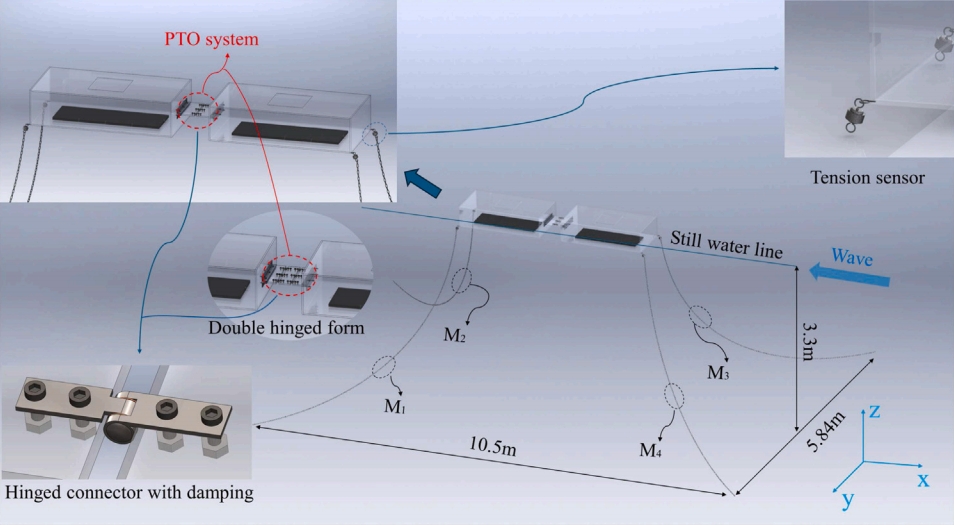
Figure 1. Schematic diagram of WEC and mooring system
The experiment used monitoring equipment to monitor the pitch motion response and relative angular velocity between the two floaters. It included eight optical motion capture cameras surrounding the pontoon WEC marked with infrared reflective balls, as shown in Figure 2. Additionally, four mooring lines were equipped with underwater tension sensors. Data was transmitted to a computer via a data acquisition system for monitoring.
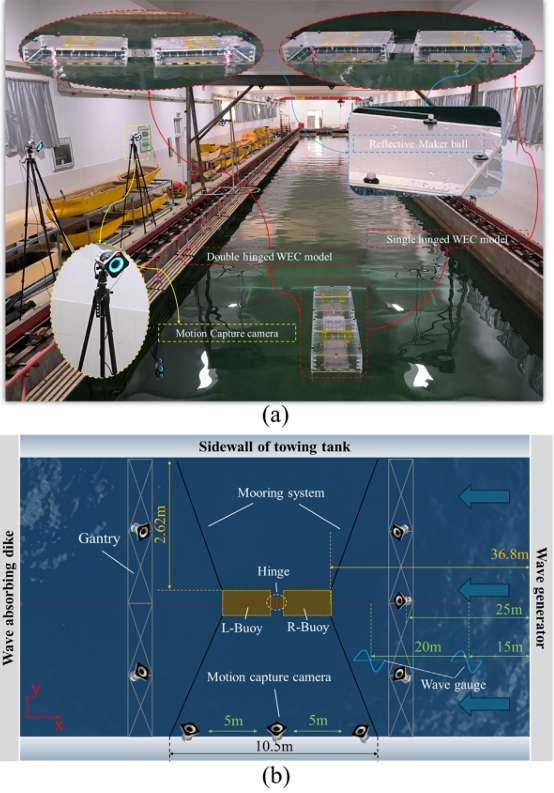
Figure 2. Experimental setup of pontoon WEC in model tests: (a) Dual-floaters marked with reflective points; (b) Experimental setup.
To ensure data reliability and scientific validity, the experimental data used was from the stable operation of the dual-floaters over ten wave cycles. After completing data collection for one wave condition, the next experiment was initiated only after the water surface had calmed.
In addition to the hinging method, floater spacing is another critical parameter affecting the connection of dual-floaters. Therefore, the model experiment evaluated the motion of dual-floaters at different spacings. The relative pitch angle between the front and rear floaters was determined by assessing the pitch response and angular velocity differences. This ensured precise and multidimensional evaluation of target motion and attitudes within the experimental framework, as shown in Figure 3, where d is the spacing between dual-floaters and L is the characteristic length of the floater.

Figure 3. Status of dual-pontoon WEC based on different d/L ratios: (a) Single-hinged WEC model; (b) Dual-hinged WEC model.
To avoid severe wave overtopping, the model experiment investigated the attitude performance of single-hinged and dual-hinged dual-pontoon WECs under a wave height of 0.10 meters. The spacing condition for the single-hinged floater was set to start from 0.30 meters (d/L = 1/4) to prevent adverse effects on the motion of the dual-floaters due to excessively short spacing, as shown in Table 1.
Table 1: Main dimensions of single floater model
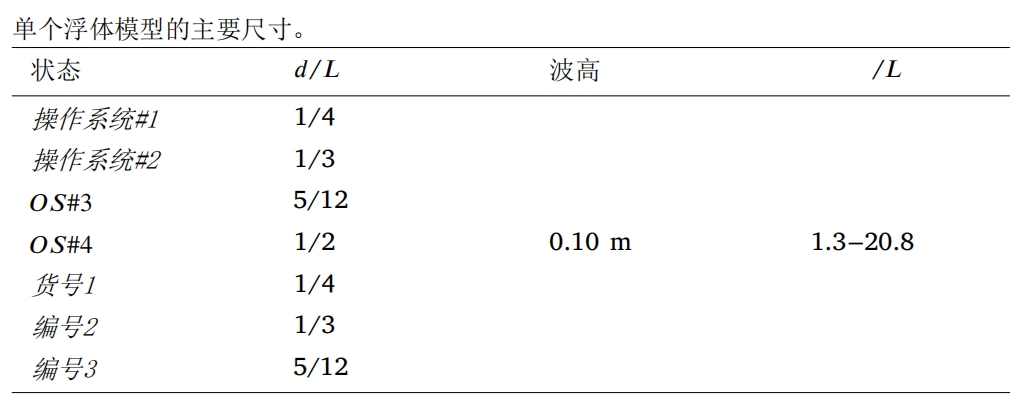
Experimental results indicate that appropriate floater spacing can reasonably utilize the hydrodynamic interaction of the device to increase the relative pitch motion of dual-floaters, thereby enhancing energy capture efficiency. These findings highlight the importance of optimizing floater spacing to improve the performance of wave energy conversion systems.
The experiment also revealed that the energy capture efficiency of pontoon-type wave power generation devices is related to wavelength. The energy capture width ratio initially increases and then decreases with increasing wavelength. When λ/L is approximately 2.0 (equivalent to the floater length being half the wavelength), the floater's energy capture efficiency is most significant, and the energy capture efficiency is maximized. Due to various influencing factors, the optimal wave frequency range exists around the most significant intermediate value, leading to maximum energy capture efficiency. To optimize the dimensions of pontoon-type wave power generation devices, it is best to maintain a 2:1 ratio with the typical wavelength of the local sea area. At the same time, different floater spacings also significantly affect the energy capture efficiency of dual-floaters, as shown in Figure 4.
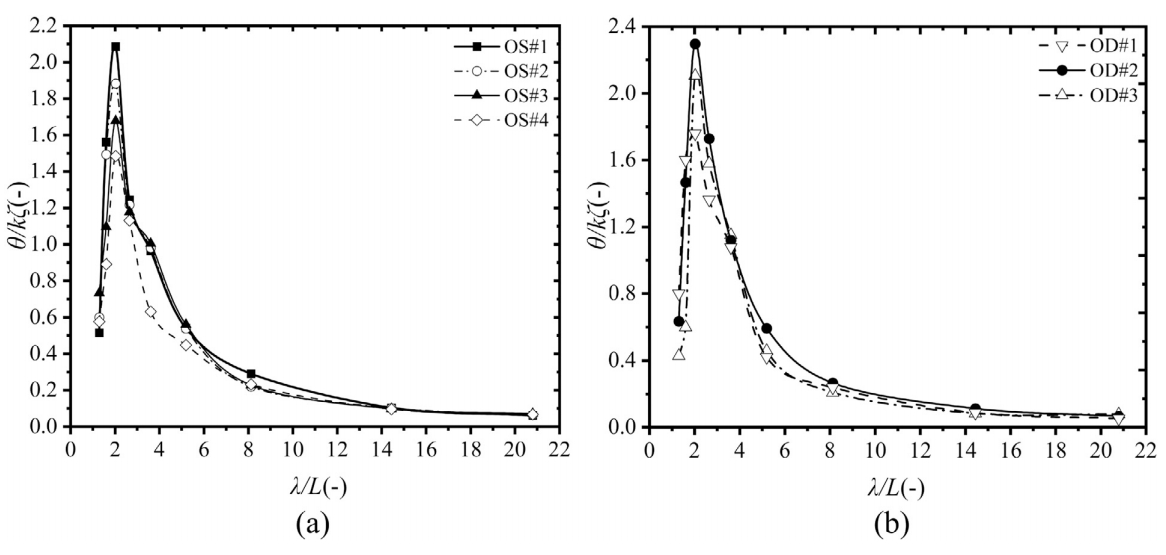
Figure 4: Relative pitch of various hinged WEC models under different d/L ratios: (a) Comparison of single-hinged WEC models under different d/L ratios; (b) Comparison of dual-hinged WEC models under different d/L ratios.
III. Numerical Model Validation
1. Numerical Tools:
The numerical simulation part provides a more detailed comparison of the motion response and energy capture efficiency of dual-hinged and single-hinged pontoon WECs under different wave parameters.
To ensure robustness and computational efficiency, the numerical simulations in this study primarily rely on potential flow-based software. Additionally, a multi-level coordinate system method was adopted in the initial hydrodynamic response calculations to accurately depict the kinematic characteristics of two interconnected floating bodies in a wave environment, as shown in Figure 5.

Figure 5. Coordinate system describing the motion of pontoon WEC in waves
Subsequently, the power take-off (PTO) unit for energy conversion efficiency calculation is illustrated in Figures 6 and 7 to clarify its functional role. In pontoon WECs, the PTO system is located between the two pontoons. Therefore, it is necessary to represent it as a torsional damper characterized by a rotational damping coefficient C. This theoretical structure is based on the linear equivalent rotation theory of the PTO system.

Figure 6. Schematic diagram of the pitch angle of pontoon WEC

Figure 7. Schematic diagram of dual-hinged WEC illustrating the rotational PTO system
2.Numerical Model Validation:
From the experimental results, the primary pitch response frequency range of the dual-pontoon WEC is between 3.14 rad/s and 5.65 rad/s. Therefore, the numerical simulation focuses on verifying the relative pitch motion of dual-floaters within this frequency range. To further validate the effectiveness of the numerical model, the pitch motion response of individual floaters under single-hinged and dual-hinged configurations was verified respectively. The comparison shows a significant consistency between the simulation results and experimental data in terms of pitch dynamic response. To enhance the accuracy of predictions from these solvers, appropriate damping coefficients were set in the PTO system to refine the simulation results, as shown in Figures 8, 9, and 10.
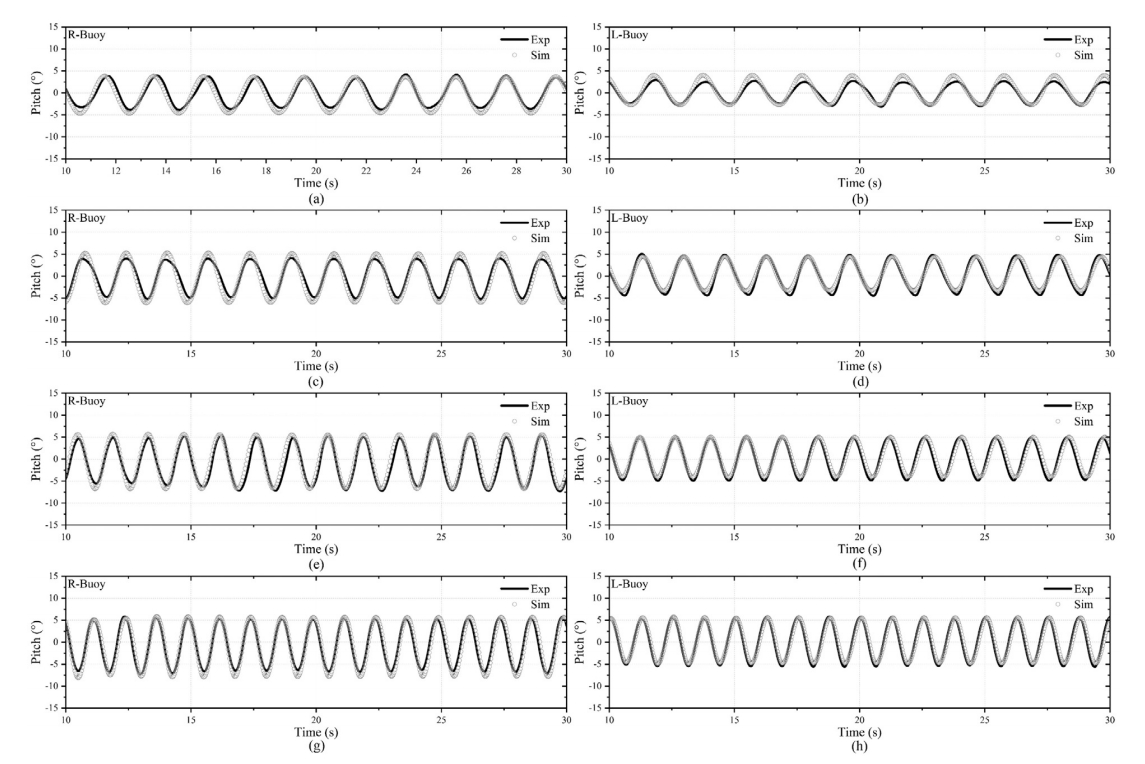
Fig. 8. Asesment of mumerical imulations corroborated with experimental results for single hinged WEc model with d/L = 1/4: (a) Right Buoy, w= 3.14 rad/s; (b) Let Buoyw= 3.14 rad/s, (c Right Buoy, 0= 3.77 rads, (d) let Buoy, o =3.77 rad/s; (e) Right Buov, w= 4.40 rd/s: (0 let Buov,o= 440 rad/s: g) kigeht Buov.@= 5.03 rad/s(h)Left Buoy.o= 5.03 rad/s.
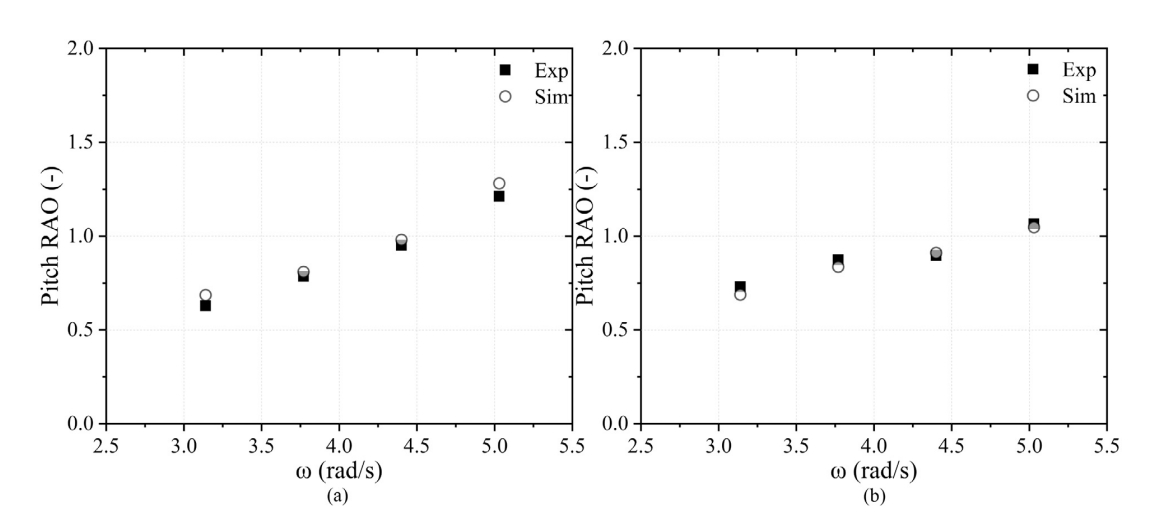
Fig. 9. Pitch RAOs of the single hinged wEc between the experimental measurements and numerical results: (a) Right Buoy; (b) Lef Buoy

Fig. 10. Assesment of numerical simulatons coroborated with experimental resuts for double hinged wEc model with d/L= 1/4: (a) Right Buy, w= 3.14 rad/s; (b) leBuoy, @ = 3.14 rad/s; (c) Right Buoy, @ = 3.77 rad/s, (d) Left Buoy, a =3.77 rad/s; (e) Right Buoy, a= 4.40 md/s, (0 Let Buoy, w= 440 rad/s; (g) Right Buoy, @= 5.03rad/s; (h) Left Buoy, o = 5.03 rad/s.
IV. Analysis of Results
By means of physical model tests, this study systematically investigated the influence of floater spacing and wave cycle parameters on the roll response and mooring tension of single/dual-hinged dual-floater wave energy conversion devices (WEC) under regular wave conditions. The tests employed an equivalent linear damping model to simulate the power take-off (PTO) system and constructed a corresponding numerical model. The high consistency between numerical calculation results and experimental data verified the reliability of the model. Numerical studies based on the validated model revealed that the type of hinge structure significantly affects the dynamic response characteristics of the dual-floater system. The research further uncovered the mechanisms by which different hinge types influence energy capture efficiency.
Floater Spacing Optimization: Experiments showed that the optimal spacing ratio for single-hinged WECs is 1/3 and for dual-hinged WECs is 1/4. Dual-hinged configurations demonstrated higher energy capture efficiency under low-frequency waves.
PTO Damping Optimization: Increasing PTO damping moderately can enhance energy capture efficiency, but excessive damping reduces floater motion amplitude and impacts overall performance.
Wave Direction Impact: Dual-pontoon WECs achieve maximum energy capture efficiency when waves approach from the front (0° incidence angle). Oblique waves reduce efficiency, yet dual-hinged configurations outperform single-hinged ones across different wave directions.
Irregular Wave Performance: Under irregular waves, dual-hinged WECs significantly outperform single-hinged configurations, particularly in low-frequency bands where they exhibit stronger capture capabilities.
Original Link:
https://doi.org/10.1016/j.energy.2025.135611
References:
[1]Shi Wei, Yan Chaojun, Ren Zhengru, Yuan Zhiming, Liu Yingyi, Zheng Siming[1]et al. Review on the development of marine floating photovoltaic systems.Ocean Eng 2023;286(Part1):115560.
[2]Qiu Shouqiang, Liu Kum, Wang Dongjiao, Ye Jiawei, Liang Fulin. A compre-hensive review of ocean wave energy research and development in China.Renew Sustain Energy Rev 2019;113:109271.
[3] Falnes J. A review of wave-energy extraction. Mar Struct 2007;20:185-201
[4] Guo B, Ringwood JV. Geometric optimization of wave energy conversion devices:a survey. Appl Energy 2021;297:117100.
[5]Drew B, Plummer AR, Sahinkaya MN. A review of wave energy convertertechnology. Proc Inst Mech Eng Part A J Power Energy 2009;223:887-902.
[6] Wang L, Kolios A, Cui L, Sheng Q. Flexible multibody dynamics modelling ofpoint-absorber wave energy converters. Renew Energy 2018;127:790-801.
[7]Liu CH, Yang QJ,Bao G.Performance investigation of a two-raft-typewave energy converter with hydraulic power take-off unit. Appl Ocean Res2017:62:139-55.
[8]Czech B, Bauer P. Wave energy converter concepts: Design challenges andclassification. IEEE Ind Electron Mag 2012;6(2):4-16.
[9] Melikoglu M, Current status and future of ocean energy sources: A global review.Ocean Eng 2018;148:563-73.
[10]McCormick M, Murthagh J, McCabe P. Large-scale experimental study of ahinged-barge wave energy conversion system. In Proceedings of the 3rd europeanwave energy conference, Patras, Greece, 30 September-2 1998:215-222.
- Prev:No Prev
- Back
- Next:Zhejiang Ocean University
